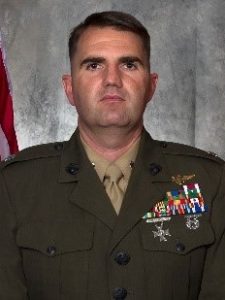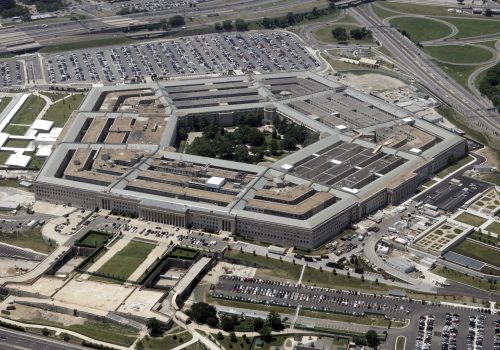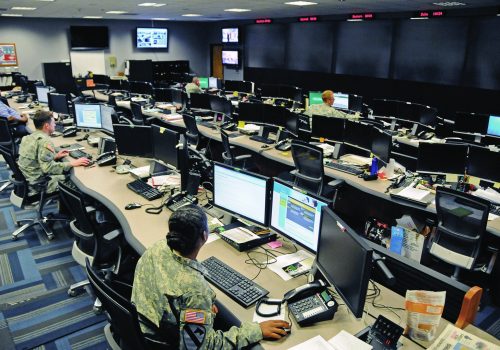A new strategy for US global defense posture
TO: US National Security Community
FROM: Matthew Crouch, Barry Pavel, Clementine G. Starling, and Christian Trotti
DATE: August 5, 2021
SUBJECT: A New Strategy for US Global Defense Posture
This Policy Brief, produced by the Scowcroft Center for Strategy and Security’s Forward Defense team, recommends a novel strategy for US global defense posture to strengthen deterrence and competitive leverage in competition with China, Russia, and other challengers.
Strategic context
Today, defense strategy and policy must be adapted to address challenges from revisionist powers, rogue nations, and violent extremist organizations. The global shift to great-power competition has been accompanied by an erosion of US overmatch in key capabilities vis-a-vis China and Russia. Moreover, conflict and competition have expanded to new arenas such as space, the Arctic, and the US homeland, while accelerating in cyberspace and the information domain. These shifts demand equally creative changes to the United States’ defense strategy, and US force posture must reflect these imperatives.
Assumptions
- Great-power competition is here to stay – Great-power competition is an apt strategic framework for how the United States and its major rivals will interact in the projected security environment. It is therefore useful for deriving strategy and US force posture. This competition will necessarily involve policy and budget tradeoffs between (1) deterrence of conventional and “gray zone” warfare in the short-term and (2) preparation of the future force for long-term competition.
- China is the primary strategic threat – While great-power competition is the right framework, it is important to distinguish between China and Russia. There is bipartisan consensus that China will continue its dramatic ascendance to become a peer competitor. China wields a robust toolset spanning military, economic, technological, diplomatic, cyber, information, and other instruments—therefore, the Department of Defense (DoD) must prioritize China as the pacing threat. While positioning itself for long-term competition with China, the United States must also balance against the challenges posed by the more risk-tolerant, declining competitor—Russia. The United States must both deter conventional and nuclear war with China and Russia and compete with them below the threshold of armed conflict. Integrated deterrence provides such a framework.
- Hybrid threats are prevalent – The United States and allies face everyday competition with China and Russia below the threshold of armed conflict. The sophistication of hybrid warfare complicates US security at home and operations abroad, requiring a more active and creative role for DoD both in the lead and in support of other agencies. The homeland as a theater will increasingly affect force design, allocation, and posture decisions. Hybrid challenges also pose unique paramilitary, information, and other threats to allies, and force posture can be one instrument in countering them.
- New domains and regions will become increasingly important – In order to prepare for great-power competition, US force posture must rebalance toward new domains (e.g., space) and previously underprioritized regions (e.g., the Arctic) that will increasingly become areas of great-power activity and resource interests. This means that more traditional regions like the Middle East, Africa, and Latin America will become economy-of-force theaters, with more limited allocations of US forces that are simultaneously capable of servicing the requirements of other regions.
- Increased connectivity and reliance on allies and industry – The United States’ greatest strategic advantage is its globe-spanning network of allies and partners, which allows it to redress its own capability gaps, multiply its strengths, and further project stability. The demands and opportunities attendant to the projected security environment suggest ever-greater US-allied collaboration and the necessity for industry-government collaboration to develop necessary capabilities.
- Budget constraints will continue – The US military is unlikely to see significant resource increases in the coming decade. This amplifies the importance of seeking force posture efficiencies.
Goals of a US global defense posture strategy
- Deterrence of great-power war – Deterring war should be the primary goal of force posture planning. US force posture should demonstrate both: 1) political willingness to fight a war, if necessary, for example through forward-stationed forces; and 2) warfighting capability, capacity, and readiness, for example through training, exercising, and exchanging information with allies. By credibly signaling these strengths, the United States can deter war in the first place.
- Deterring Nuclear Conflict – The United States must posture its strategic forces at home and abroad to ensure an effective second-strike capability in multiple contingencies.
- Deterring Conventional Conflict – US force posture should aim to deter conventional conflict with China and Russia, primarily by providing combat-credible forces ready to respond within required timelines and thereby to prevent fait accompli attacks.
- In the Indo-Pacific – US posture should be focused with allies on deterring China from seizing Taiwan and responding to a crisis in the South China Sea, while contributing to the deterrence of a North Korean attack alongside ROK forces.
- In Europe – the United States should develop its posture in cooperation with NATO allies and partners to prevent Russian aggression in Eastern Europe, particularly in the Baltic Sea Region, the Black Sea, and increasingly the Arctic; as well as to counter and deter more present extensions of Chinese power in Africa, the Mediterranean, and the Arctic.
- The Middle East – should be an economy-of-force theater. Given that the threat posed by Iran is orders of magnitude less than that posed by China and Russia, the United States should be willing to tolerate much greater risk for in-theater requirements, including by reducing force posture. CENTCOM forces should also be capable of supporting out-of-theater INDOPACOM and EUCOM requirements.
- Support competition below the threshold of conflict – The United States and its allies face below-threshold competition (i.e., hybrid or gray-zone attacks) every day. This includes cyber and information warfare designed to fragment US and allies’ domestic political environments (e.g., election interference and disinformation); economic competition designed to cleave US allies and partners and create dependency (e.g., Russia’s Nord Stream 2 and China’s Belt and Road Initiative); paramilitary threats designed to gradually change the regional status quo (e.g., Russian special operations forces in Ukraine and China’s Maritime Militia harassment in the South and East China Seas); and coercive diplomacy designed to pressure countries into favorable behavior (e.g., diplomatic and economic sanctions.) While posture will not solely determine competition, it can impact the environment in which hybrid warfare is conducted. Posture can help manage paramilitary threats, for example by deterring Chinese maritime harassment in the Indo-Pacific or Russian “little green men” scenarios. The broader signaling and presence inherent in posture may counteract certain attacks by demonstrating US commitment to allies and to regional security.
- Pursue integrated deterrence with allies – Force posture is key to strengthening a global collective security framework. US priorities and security commitments can be achieved in part through effective presence and posture, which provide the ability to respond to contingencies. US military presence should fit into a strategy of “integrated deterrence” aimed at combining the strength of the United States and its allies into a highly networked, technologically superior force to achieve overmatch over potential adversaries. This will enable the United States and its allies to more effectively conduct multi-domain operations and pursue joint US-allied planning. US presence should reinforce this integrated deterrence concept and encourage similar commitments from allies, helping to “force multiply” deterrence. US force posture should also: 1) reassure allies of the US commitment to its security guarantees; 2) signal to adversaries the strength and cohesion of the US alliance network; 3) be matched by a commitment to collective security by allies and partners; and 4) enhance security in key regions by providing nimble, responsive, and ready forces.
- Prepare for the future force – Emerging technologies and operational concepts are redefining the future of warfare. Planners must tradeoff between: 1) building the force structure and posture required to deter and prevail in conflict today; and 2) laying the foundation for new capabilities necessary to deter and prevail in conflict in the longer term. Today’s force posture must support a future force. Most importantly, just as technologies create new tradeoffs, they can also resolve old ones—newer capabilities with greater global reach may satisfy military requirements in multiple regions simultaneously, reducing region-vs-region tradeoffs to outdated, false dichotomies.
Pillars of a US global force posture strategy
Geographic Considerations
- Prioritize the homeland as a critical theater – In the past, US forward deployments were able to effectively deter and prevent major kinetic threats to the US homeland. However, in a future great-power conflict, China or Russia may decide to attack the United States with long-range conventional weapons, cyberattacks on critical US infrastructure, attacks on space capabilities, and a wide range of hybrid (e.g., sabotage missions by special operations forces) and non-kinetic operations. Planners must consider how to allocate forces to deter and defend against these threats.
- Build a globally-oriented strategic force – For all US forces, a premium will be placed on thinking and acting globally, as the challenges that the United States faces are not limited to any one region. While command and control of forces in theater should still reside with the regional combatant commanders, forward-stationed forces must be conceived and postured to serve both in-theater and out-of-theater requirements. Moreover, non-theater-based forces like nuclear and hypersonic weapons, which reside in CONUS or traverse the open seas and have global reach, must feature significantly in a variety of deterrence operations and war plans abroad. The ability of other combatant commands to leverage out-of-theater forces, when necessary and as directed by the President and Secretary of Defense, should be codified in an updated Unified Command Plan.
- Prioritize mobility- and range-determined basing – Force posture decisions will consider mobility and range as key variables in determining basing and forward deployments, as such:
- Units with the greatest mobility and range, such as air, missile, and space assets and certain naval forces, as well as valuable mobility enablers like tankers, should be positioned in a manner that maximizes their ability to surge in crisis and conflict, thereby increasing mass to theaters abroad and supporting operations across the globe. Agile forces should be postured to strengthen their capability to support requirements in both priority regions.
- Less rapidly mobile forces, such as armored brigade combat teams (ABCTs) and other naval forces, should be home-stationed in forward areas to bolster presence, enhance response times in crisis, improve deterrent and competitive capabilities, and reduce costs associated with rotational force deployment. These forces, though primarily oriented toward in-theater requirements, should not be precluded from deploying into other theaters to address emerging needs as dictated by a globally oriented force allocation model.
This shift in posture strengthens deterrence by allocating missions to units based on their mobility and range. Units with greater mobility and range can respond to a variety of warfighting scenarios in multiple regions, allowing rapid surging and mass to respond to, blunt, and potentially roll back attacks. Units that lack such mobility due to heavy logistical constraints should be home-stationed in key regions, decreasing their distance from flashpoints and enabling them to respond on shorter timelines. This basing construct helps redress the resource burdens incurred by rotational deployments.
Non-Geographic Considerations
- Lay the foundation for the 2030s force – US force posture should be sufficient for deterrence, competition, and assurance today, while also providing a “bridge” to a posture that incorporates emerging capabilities like hypersonic weapons, swarming autonomous systems, directed energy-enabled missile defenses, and space-based systems over time. For example, while many hypersonic weapons will have intercontinental range, it will still be useful to forward-deploy them in order to complicate adversary targeting, shorten operational timelines, and share the responsibility of basing these weapons with allies. Forward-deployed US units should be the vessel through which these hypersonic weapons are first introduced to theaters abroad and to allies, and they should be prepared today to assume that role tomorrow, laying the foundation for this and other emerging capabilities.
- Create latticed defense by developing a US and allied combined joint force posture – The growing capability and size of adversary forces, as well as new technology opportunities, point to the need to significantly ramp up cooperation between the United States and allies to garner mass and redress US capability gaps, and to do so affordably. In line with the pursuit of integrated deterrence, the United States should work towards crafting a combined joint force posture with allies to capitalize upon growing allied capabilities (e.g., in space and artificial intelligence), build multi-domain awareness in multiple theaters, encourage allies and partners to work together in some cases without the United States, and jointly pre-position equipment. Allies could harness new technologies in new operational concepts to cost effectively contribute much more to collective defense efforts against potential adversaries, including by co-producing and deploying relatively cheaper massed autonomous systems, containerized cruise missiles, and smart mines that are most effective as denial capabilities. For example, South Korea could provide greater ground forces in tandem with these capabilities to blunt North Korean attacks, buying more time for US and coalition forces to surge in response. The creation of a truly latticed defense, as opposed to a hub-and-spokes approach, will help the United States achieve its national defense strategy goals.
Principles for executing a US global force posture strategy
Decisionmakers should consider the following principles. Each one impacts either an aspect of current posture or has broad implications for modernization, force design, procurement, or resource allocation.
- Designate a global posture integrator – The Under Secretary of Defense for Policy should serve as the global posture integrator, helping the Secretary of Defense to develop, apply, and enforce a global posture strategy against which specific posture change proposals can be assessed. An ineffective global posture would be one comprised of a collection of regional postures that do not fit together nor are driven by a broader, coherent global strategy. The global defense posture of the United States should be driven top-down by civilian officials in close coordination with military officials and raised, ultimately, for the approval of the President of the United States.
- Jointly develop key requirements with allies – Deliberate, systematic efforts to bring allies into combined force posture planning will be necessary to ensure the highest interoperability of today’s capabilities and modernization. Developing a combined force posture with treaty allies will enhance both deterrent and competitive effects. For example, in NATO, enhanced readiness metrics and multi-domain awareness goals should be designed and implemented.
- Rely on and support other agencies and actors – For theaters or domains where the US military should not be the primary instrument for competition, DoD should lean heavily on and work closely with USAID, the Departments of Commerce and State (DoC and DoS), and private-sector actors. The US competitive position in AFRICOM, for example, would be greatly enhanced by USAID structuring financial incentives for 5G and other digital capabilities to be provided by vendors from the United States and allies. Ideally, DoD, USAID, DoC, and DoS would develop an integrated global US competition strategy to marry defense capabilities in key regions with the application of US and allied technological, financial, development, diplomatic, and information tools.
- Integrate non-kinetic fires into operational planning – To combat cyber, information, diplomatic, economic, and other hybrid attacks and threats from adversaries, the United States should include non-kinetic fires in its strategy. Non-kinetic fires, for example in the information domain and by offensive cyber operations, should be incorporated into globally oriented strategic forces and should be aimed at bolstering mass both below the threshold and above it.
- Move to a platforms-per-crew rather than crews-per-platform model – The United States cannot afford to sustain the size of the current force structure. Fortunately, advances in technology will allow for fewer crews to control multiple, affordable, and attritable semi- and autonomous systems. This will require further investments in artificial intelligence, extensive sensor-shooter system development, and a robust, survivable, and redundant C2 infrastructure. Autonomous systems may simultaneously bolster warfighting capability through swarming while sufficiently increasing competitive leverage and presence below the threshold of conflict to deter hybrid threats (e.g., uncrewed aerial, maritime, and undersea systems may deter the Chinese Maritime Militia).
- Establish baseline resiliency goals – To counter disinformation and cyberattacks that risk disruption to critical infrastructure and communications networks on which US forces rely in wartime and peacetime, decisionmakers must set baseline resiliency goals. All forces based in the United States and abroad should work towards a minimum standard of network and infrastructure resiliency.
The present and future security environment requires a more sophisticated force posture to deter, compete with, and defend against major rivals. This Policy Brief articulates a novel strategy for US global defense posture that addresses multifaceted challenges abroad, allocates missions according to mobility and range, lays the foundation for emerging technologies, and facilitates robust cooperation with allies and partners.
About the authors
Related content

Forward Defense, housed within the Scowcroft Center for Strategy and Security, generates ideas and connects stakeholders in the defense ecosystem to promote an enduring military advantage for the United States, its allies, and partners. Our work identifies the defense strategies, capabilities, and resources the United States needs to deter and, if necessary, prevail in future conflict.
Image: Cover image credit: US Marine Corps photo by Cpl Codey Underwood / Released, US Marine Corps flickr





